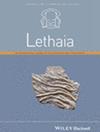东格陵兰岛中部Rhætelv组(Kap Stewart群)中一个新的脊椎动物化石层:Hettangian海相侵入Jameson陆相盆地的证据
IF 1.9
4区 地球科学
Q1 PALEONTOLOGY
引用次数: 1
摘要
传统上被认为是一个严格意义上的大陆单元,有三角洲和多年生湖泊沉积物。然而,在Kap Stewart组Rhætelv组中部的一层薄的风暴沉积砂岩层中,新发现的蛇颈龙骨头表明可能存在海洋影响时期。在盆地东缘的研究区,Rhætelv组厚度为300 m,不整合地覆盖在Norian Fleming峡湾群上。含骨砂岩产于群底上方190 m处,与黑色层状泥岩密切相关;3个样品的孢粉学研究表明,这些泥岩属于较年轻的河塘期。Hettangian是一个相对较短的阶段(201.3-199.5 Ma),其他地区则以两次海平面上升为特征。假设由蛇颈龙化石遗骸所证明的詹姆逊陆地盆地的海侵发生在这些海平面最年轻的时期,那么Rhætelv组的含骨层可以追溯到200 Ma,从而为这一迄今为止尚未确定年代的演替提供了第一个数字年龄约束。□Hettangian, Jameson陆盆,Kap Stewart群,海洋入侵,蛇颈龙。本文章由计算机程序翻译,如有差异,请以英文原文为准。
A new vertebrate fossil‐bearing layer in the Rhætelv Formation (Kap Stewart Group) of central East Greenland: evidence of a Hettangian marine incursion into the continental Jameson Land Basin
has traditionally been regarded as a strictly continental unit with delta and perennial lake sediments. New finds of plesiosaur bone remain in a thin storm deposited sandstone bed in the middle part of the Rhætelv Formation of the Kap Stewart Group, however, indicates a likely period of marine influ-ence. At the study area at the eastern margin of the basin, the Rhætelv Formation is 300‐m thick and overlies unconformably the Norian Fleming Fjord Group. The bone‐ bearing sandstone occurs 190 m above the base of the group and is closely associated with black laminated mudstones; palynological investigation of three samples from these mudstones indicates that they are of a younger Hettangian age. The Hettangian was a relatively short stage (201.3–199.5 Ma) and elsewhere characterized by two episodes of sea‐level highstands. Assuming that the marine incursion in the Jameson land Basin evidenced by the plesiosaur fossil remains took place during the youngest of these sea‐level highstands, the bone‐bearing bed of the Rhætelv Formation can be dated to 200 Ma and thereby gives the first numerical age constraint of this hitherto poorly dated succession. □ Hettangian, Jameson Land Basin, Kap Stewart Group, marine incursion, plesiosaur.
求助全文
通过发布文献求助,成功后即可免费获取论文全文。
去求助
来源期刊

Lethaia
地学-古生物学
CiteScore
3.30
自引率
0.00%
发文量
27
审稿时长
6-12 weeks
期刊介绍:
A formal publication outlet for the International Palaeontological Association (IPA) and the International Commission on Stratigraphy (ICS), Lethaia publishes articles of international interest in the fields of palaeontology and stratigraphy. The articles concentrate on the development of new ideas and methods and descriptions of new features of wide significance rather than routine descriptions.
Palaeobiology and ecostratigraphy are the core topics of the journal. In addition to articles, Lethaia contains shorter contributions in the form of discussions, presentations of current scientific activities, reviews and editorials.
Lethaia was launched in 1968 as a joint venture between scientists in Denmark, Norway, and Sweden, with the aim of promoting the development of modern methods in scientific publishing and of providing a medium for rapid publication of well-prepared manuscripts of wide international interest.
 求助内容:
求助内容: 应助结果提醒方式:
应助结果提醒方式:


